
Aki Products 1/72 Sea Fury FB.11
| KIT #: | ? |
| PRICE: | $85.00 MSRP |
| DECALS: | Two options |
| REVIEWER: | Tom Cleaver |
| NOTES: | Resin kit |

| HISTORY |
Had the Hawker Sea Fury arrived on the scene one year earlier than it did, its
place in history would be assured by the outstanding combat record it would
undoubtedly have achieved with the British Pacific Fleet in the final struggles
of 1945. As it is, the Sea Fury - designed for air superiority - is known for
shooting down only one opponent, a MiG -15 on August 2, 1952, by Lt. Peter "Hoagy"
Carmichael of 802 Squadron. Given that in the intervening five years between its
appearance in squadron strength and that day in 1952 technological development
had rendered the Sea Fury obsolete, its victory over the MiG-15 is even more
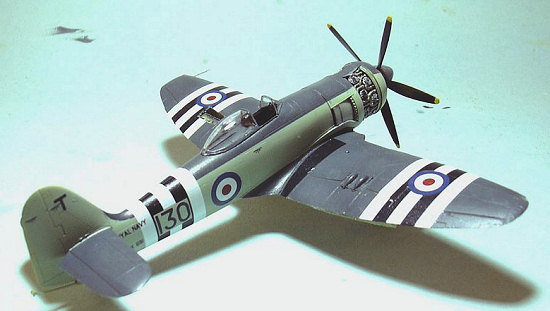 remarkable. Regardless, the Sea
Fury is the penultimate result of Sir Sidney Camm's philosophy of piston -engine
fighter design.
remarkable. Regardless, the Sea
Fury is the penultimate result of Sir Sidney Camm's philosophy of piston -engine
fighter design.
The Sea Fury began life in 1942 with a request by the Air Ministry that Hawker Aircraft design a long -range fighter for operations in the Far East. While a radial -engine version of the Tempest was under development at the time, it was thought that the relatively high wing -loading of the Tempest would be ill -suited for combat with the lightly -loaded Japanese fighters, and thus the Sea Fury started out as the "Tempest Light Fighter (Centaurus)." In early 1943, the designers were directed to adapt the fighter for shipboard operation as well as the land -based role.
The first RAF prototype flew in September 1944, while the first navalized prototype flew in February 1945. Tests revealed a need for an increase in vertical fin and rudder size to counter the swing on take -off, while the rigid engine mounts created difficulty until they were replaced with dynafocal-base mounts which completely eliminated the vibration at lower speeds that had hampered the airplane's ability to land aboard ship.
While the Royal Navy was testing both the Meteor and the Vampire and had ordered the Supermarine Attacker, there was sufficient doubt about the ability of jets to operate off carriers that - while the RAF canceled the land-based Fury in the face of the arrival of the new jets - the Royal Navy continued to develop the Sea Fury as a shipboard interceptor and later as a fighter-bomber. With carrier compatibility trials completed in 1947, 807 Squadron was the first to convert to the aircraft, followed by 802, 803 and 805 Squadrons between August 1947 and February 1948. The initial Sea Fury Mk.X was quickly replaced by the F.B.11, which could carry underwing drop tanks, bombs and rockets, and the squadrons began to equip with it in May 1948.
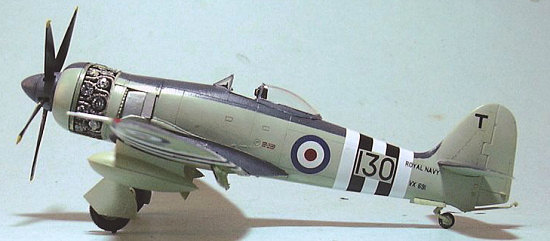 The Sea Fury's
introduction to combat came in the fall of 1950 when 807 Squadron, operating
from HMS "Theseus," joined Task Force 95, the Korean blockade force. Operating
jointly with Firefly FR Mk IV and FR Mk V strike aircraft, Sea Furies flew from
HMS "Triumph," "Theseus," "Glory," and "Ocean," as well as with the RAN from
HMAS "Sydney" until the end of the war in July 1953.
The Sea Fury's
introduction to combat came in the fall of 1950 when 807 Squadron, operating
from HMS "Theseus," joined Task Force 95, the Korean blockade force. Operating
jointly with Firefly FR Mk IV and FR Mk V strike aircraft, Sea Furies flew from
HMS "Triumph," "Theseus," "Glory," and "Ocean," as well as with the RAN from
HMAS "Sydney" until the end of the war in July 1953.
Following the end of the Korean War, the Sea Fury was rapidly replaced by its successor, the Hawker Sea Hawk, and became the primary aircraft assigned to the RNVR "weekend warrior" squadrons.
The Sea Fury was used by the Royal Australian Navy, the Royal Canadian Navy, the Royal Netherlands Navy, the Pakistani Air Force, the Iraqi Air Force and the Cuban Air Force; it last saw combat when flown by Cuban pilots of the FAR against the Cuban exile invasion attempt at the Bay of Pigs in April 1961. In the 1960s it began another career as a civilian air racer, and highly-modified Sea Furies powered by Wright R-4360 engines in place of the Centaurus are among the fastest unlimited-class air racers now competing.
| THE KIT |
There have been at least two 1/72 scale Sea Furies released over the years, one
from Frog and the other from MPM that I know of (as well as one from Pioneer.
Ed). High Planes models has also released limited-run 1/72 kits of modern
Sea Fury racers, and there is a 1/72 FB Mk 11 that will be released by Trumpeter
later this year. In 1/48 there was a good vacuform from Falcon that is
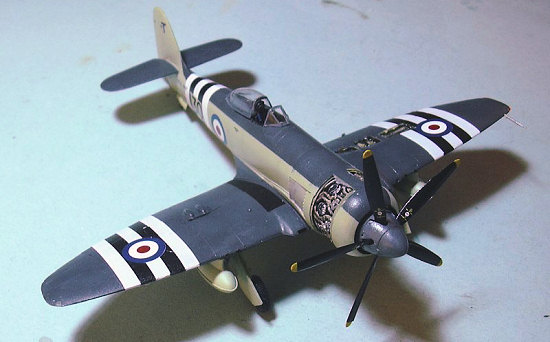 still the most accurate kit in
this scale, and one from Hobbycraft that has been widely produced since it first
appeared in 1986. Paul Fisher’s 1/32 Sea Fury is generally considered the
“definitive” kit of this beautiful airplane.
still the most accurate kit in
this scale, and one from Hobbycraft that has been widely produced since it first
appeared in 1986. Paul Fisher’s 1/32 Sea Fury is generally considered the
“definitive” kit of this beautiful airplane.
This 1/72 kit by Aki can stand close comparison with the magnificent Fisher Sea Fury in terms of detail and production quality, which is remarkable when one considers this is done in the smaller scale. This kit features posable flaps, open detailed gun bays, and a complete Centaurus engine that can be displayed with the cowling opened.
The parts of the kit are amazing in 1/72. The wing is in three parts - upper, lower, and the fuselage fairing, with fully detailed wheel wells, flap wells that have wing rib detail in them, and gun bays as mentioned. The clear resin canopies are as thin as vacuforms; both closed and open options are provided.
Decals are for a Sea Fury FB Mk 11 operated from HMS Theseus in the Korean War, which are taken from the Royal Navy Historic Flight’s Sea Fury, and an Iraqi Sea Fury in desert camouflage.
| CONSTRUCTION |
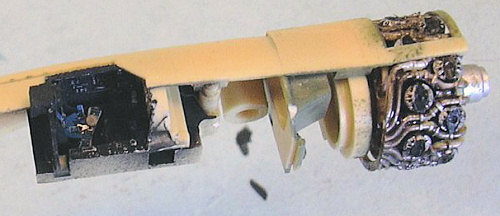 Construction of this kit
was as easy as was construction of the Aki Products Blackburn Firebrand. As was
the case with that kit, a modeler will have to actively work at it to screw this
up in assembly, though it is more fiddly than the earlier kit.
Construction of this kit
was as easy as was construction of the Aki Products Blackburn Firebrand. As was
the case with that kit, a modeler will have to actively work at it to screw this
up in assembly, though it is more fiddly than the earlier kit.
I started by painting the cockpit black and then dry-brushing with flat aluminum, then picking out the instrument panel detail and side panel detail with flat white. I finished that with the addition of Eduard seat belts.
Next was the engine. Assembly of this is easy, since all parts are keyed for
correct fit. I painted the engine and the exhausts separately, then attached the
exhausts, which are a snap fit.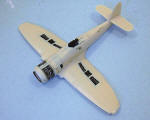
The cockpit and engine were attached to the fuselage half and then the rest of the fuselage was assembled.
For the wings, I started by painting the ammo trays and feed drums, the attached them to the lower wing half, and attached the upper wing halves. The gun bay doors were held in position with white glue.
Wing and fuselage were attached, and the horizontal stabs were attached. At this point it was time for paint.
| COLORS & MARKINGS |
Painting:
The model was painted with Xtracrylix Sky and Extra Dark Sea Grey, which were
both lightened 10 percent with Xtracrylix white, and then lightened after the
first application with a touch of Xtracrylix Lig ht
Aircraft Grey for post-shading. The propeller was painted with Xtracrylix Night
Black, with Trainer Yellow tips. When all was dry, the model received two coats
of Xtracrylix Gloss Varnish.
ht
Aircraft Grey for post-shading. The propeller was painted with Xtracrylix Night
Black, with Trainer Yellow tips. When all was dry, the model received two coats
of Xtracrylix Gloss Varnish.
Decals:
I tacked the outer flaps in position with white glue for application of the Korean War ID stripes. The kit decals were used and they are excellent. The black and white stripe decals go on easily, with the white opaque enough to not let the dark grey bleed through. All decals went down without problem with a light coating of Micro-sol.
| FINAL CONSTRUCTION |
Assembling the landing gear was probably the hardest part of the entire project. The legs come in two parts and needed to have some flash removed. Past that, I was impressed with the level of detail here, which is only exceeded by the Fisher 1/32 Sea Fury. I attached the flaps in the full down position to display the interior detail, which includes a wire molded in for the hinge.
I used the two-part canopy posed in the open position, and attached the rubber main wheels.
| CONCLUSIONS |
This kit, along with the Blackburn Firebrand from the same company, is the most
detailed full resin kit I have seen. As I said above, it can be compared in
quality and in detail with the 1/32 Fisher Sea Fury - though of course the
larger has more small detail,  but
when was the last time you could make that sort of comparison? As with the
Firebrand, it is a “fall together” kit in terms of production design, and a
modeler who had never built a full resin kit could do this with the full
likelihood of producing a show-stopper.
but
when was the last time you could make that sort of comparison? As with the
Firebrand, it is a “fall together” kit in terms of production design, and a
modeler who had never built a full resin kit could do this with the full
likelihood of producing a show-stopper.
As I said about the Firebrand, this kit is not for the “casual” modeler, but rather for the modeler who really loves the Sea Fury and is willing to pay the freight to have a “definitive” model of this beautiful airplane in their collection. $85 is steep, but the kit provides value for the money and will outshine the recent 1/72 Sea Fury from Trumpeter on all points but price. One might consider getting the Trumpeter kit to provide decal options for this kit, since there are only the FAA Korean markings or an Iraqi Sea Fury.
August 2007
Copyright ModelingMadness.com. All rights reserved. No reproduction in any form without express permission from the editor.
If you would like your product reviewed fairly and quickly, please contact the editor or see other details in the Note to Contributors.